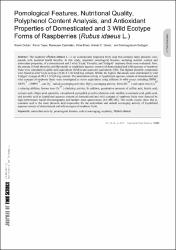Pomological Features, Nutritional Quality, Polyphenol Content Analysis, and Antioxidant Properties of Domesticated and 3 Wild Ecotype Forms of Raspberries (Rubus idaeus L.)

Göster/
Erişim
info:eu-repo/semantics/restrictedAccessTarih
2011Erişim
info:eu-repo/semantics/restrictedAccessÜst veri
Tüm öğe kaydını gösterKünye
Gülçin I, Topal F, Çakmakçı R, Bilsel M, Gören AC, Erdogan U. Pomological features, nutritional quality, polyphenol content analysis, and antioxidant properties of domesticated and 3 wild ecotype forms of raspberries (Rubus idaeus L.). J Food Sci. 2011 May;76(4):C585-93. doi: 10.1111/j.1750-3841.2011.02142.x. PMID: 22417339.Özet
The raspberry (Rubus idaeus L.) is an economically important berry crop that contains many phenolic compounds with potential health benefits. In this study, important pomological features, including nutrient content and
antioxidant properties, of a domesticated and 3 wild (Yayla, Yavuzlar, and Yedigol)¨ raspberry fruits were evaluated. Also,
the amount of total phenolics and flavonoids in lyophilized aqueous extracts of domesticated and wild ecotypes of raspberry
fruits were calculated as gallic acid equivalents (GAEs) and quercetin equivalents (QE). The highest phenolic compounds
were found in wild Yayla ecotype (26.66 ± 3.26 GAE/mg extract). Whilst, the highest flavonoids were determined in wild
Yedigol¨ ecotype (6.09 ± 1.21 QA/mg extract). The antioxidant activity of lyophilized aqueous extracts of domesticated and
wild ecotypes of raspberry fruits were investigated as trolox equivalents using different in vitro assays including DPPH ,
ABTS + , DMPD + , and O2
− radical scavenging activities, H2O2 scavenging activity, ferric (Fe3+ ) and cupric ions (Cu2+
) reducing abilities, ferrous ions (Fe2+ ) chelating activity. In addition, quantitative amounts of caffeic acid, ferulic acid,
syringic acid, ellagic acid, quercetin, α-tocopherol, pyrogallol, p-hydroxybenzoic acid, vanillin, p-coumaric acid, gallic acid,
and ascorbic acid in lyophilized aqueous extracts of domesticated and wild ecotypes of raspberry fruits were detected by
high-performance liquid chromatography and tandem mass spectrometry (LC-MS-MS). The results clearly show that pcoumaric acid is the main phenolic acid responsible for the antioxidant and radical scavenging activity of lyophilized aqueous extracts of domesticated and wild ecotypes of raspberry fruits.

















